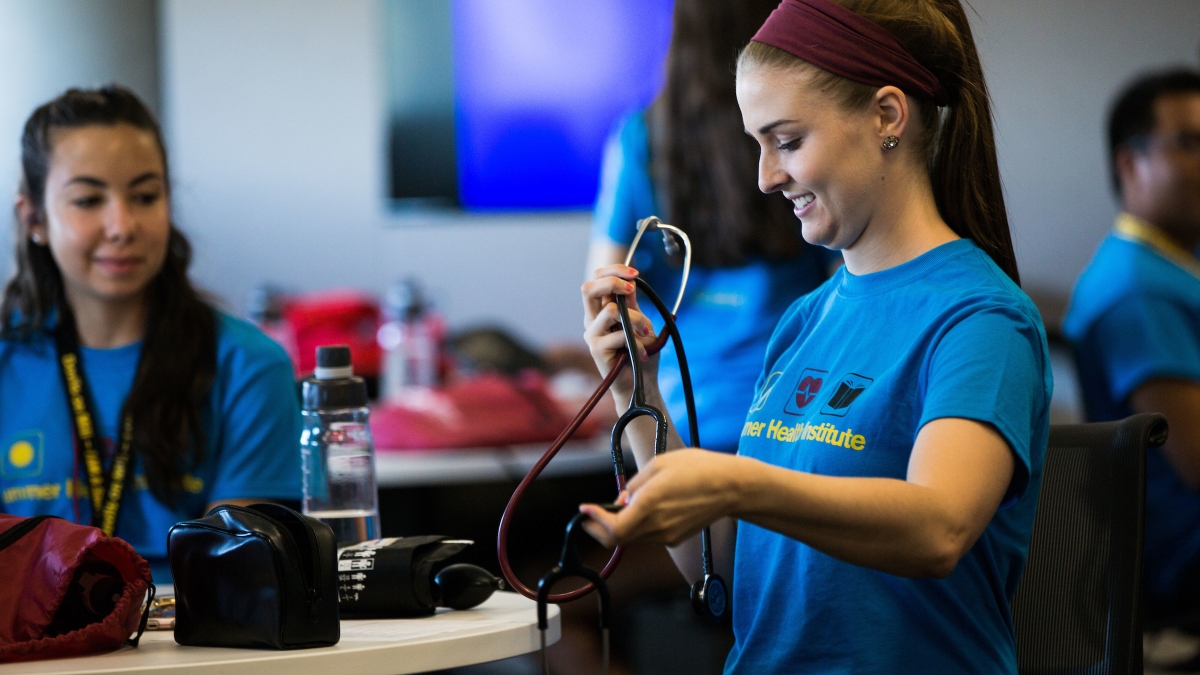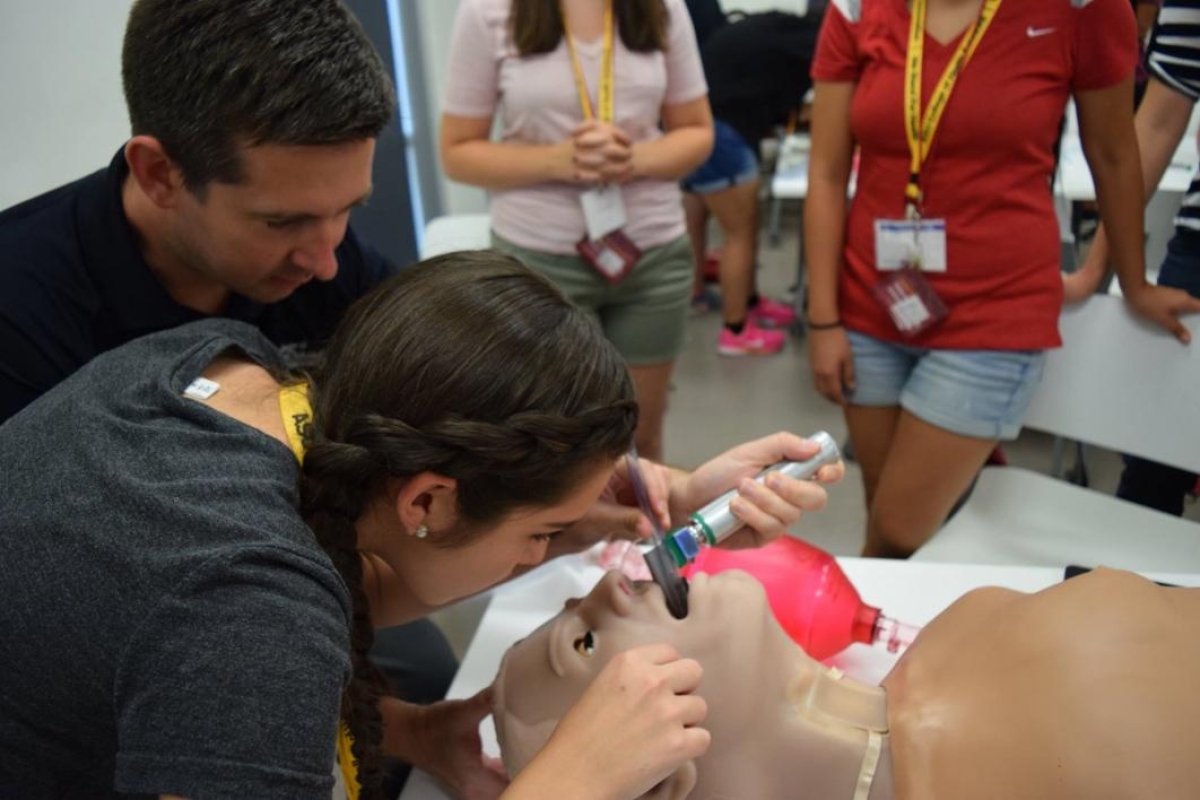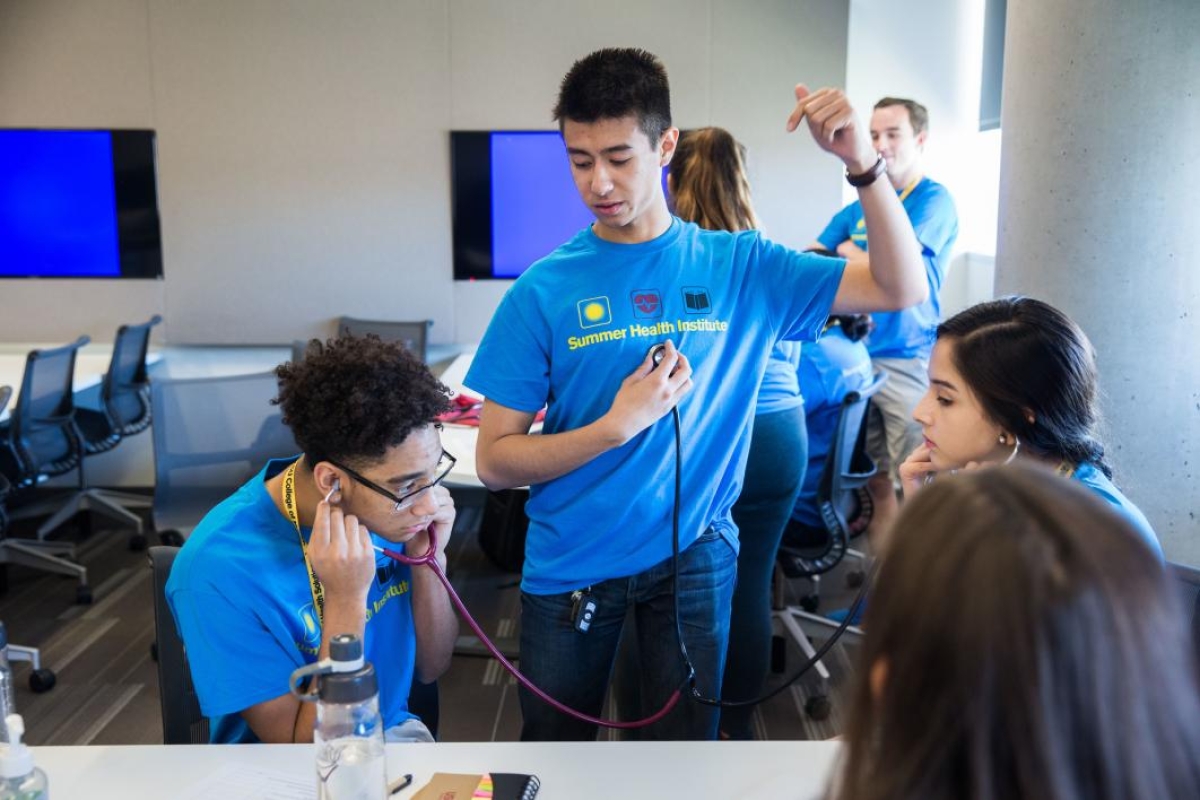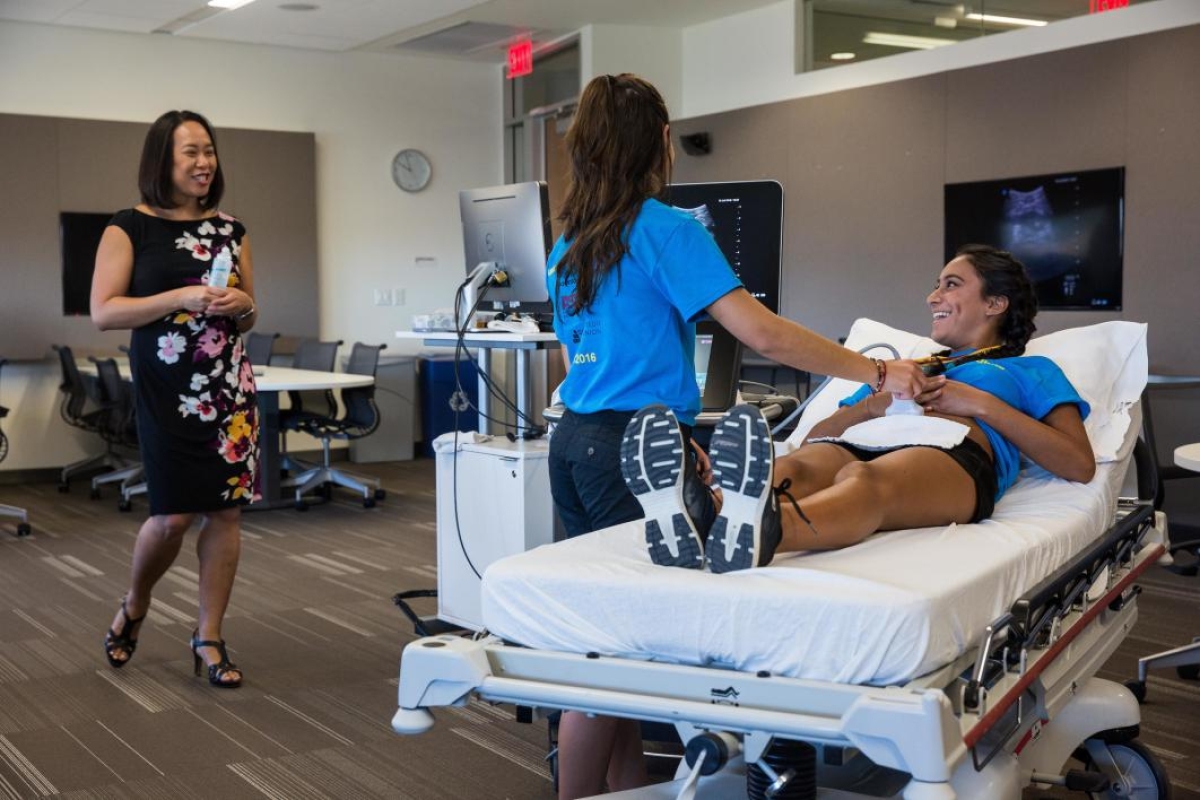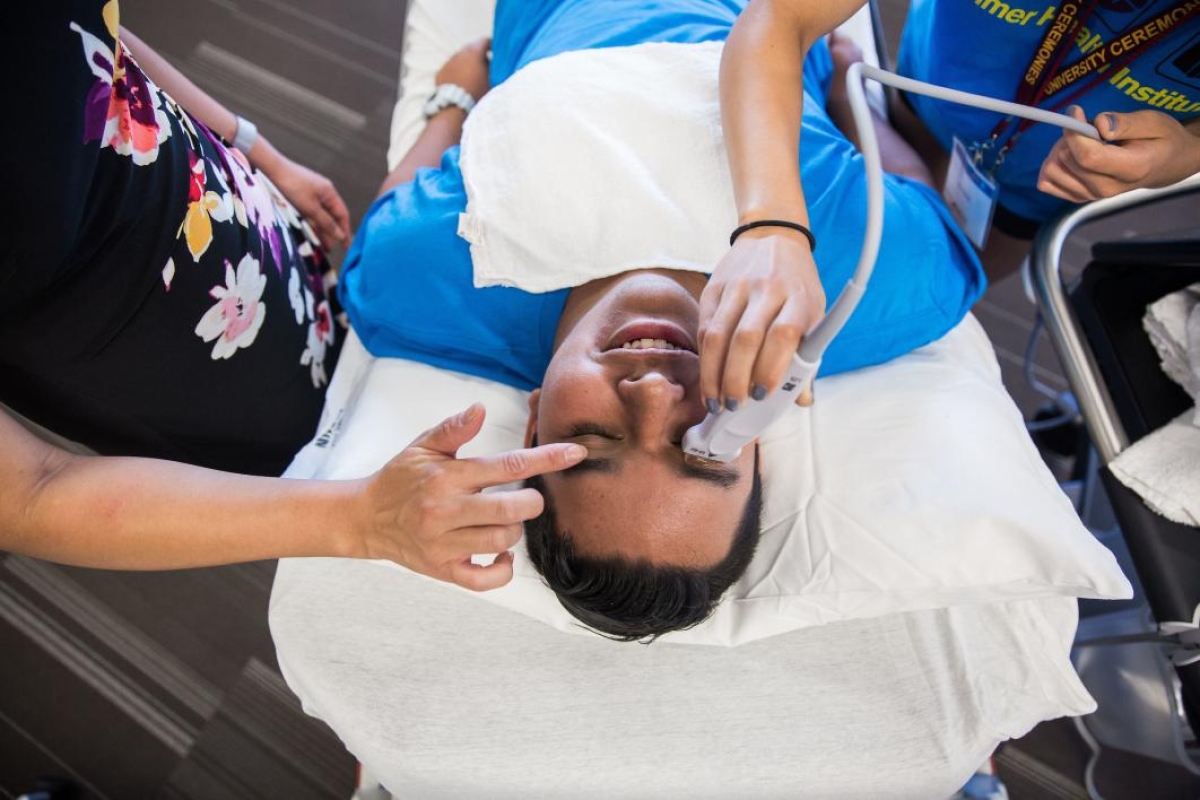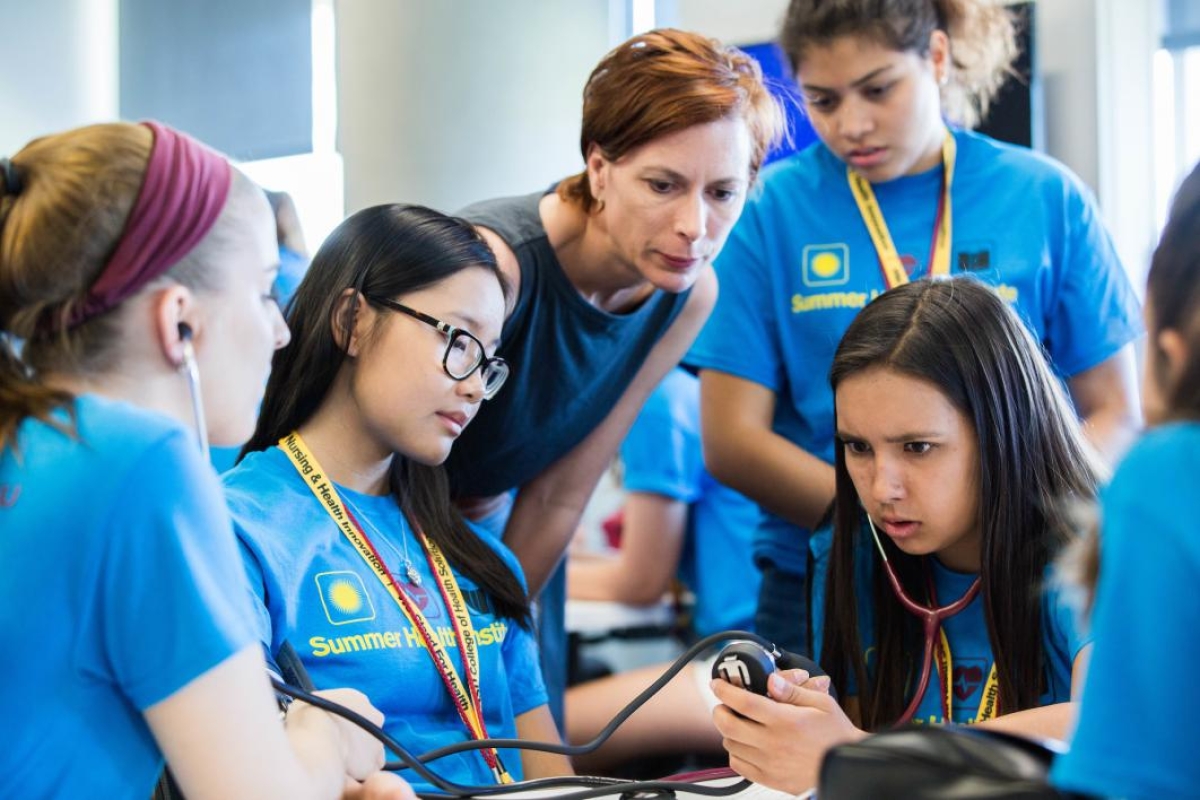Taking care to place the stethoscope in just the right spot on his chest, Kelvin Tran waits patiently for the student at the other end of the device to confirm that he hears a heartbeat.
Tran, a College of Health Solutions rising junior, has gotten used to more complex equipment since he began research in genomics and neurophysiology at ASU’s Biodesign Institute in Tempe. But today he’s taking time to help out with the college’s Summer Health Institute at the Downtown Phoenix campus, which aims to expose high school students to a variety of health professions before they get to college.
“I’m here to just kind of work with the students and oversee them, but I’m also giving advice about things like med school applications, and mistakes I should have been more aware of as a freshman,” he said, “or even just cool opportunities that I wish I knew about beforehand.”
According to clinical associate professor Alison EssaryEssary also serves as director of academic partnerships for the College of Health Solutions, and associate director of the School for the Science of Health Care Delivery., there’s a big need for that.
“Many [similar] programs target college-age students, and by the time students reach college, a lot of them have already committed to a certain pathway,” she said. “So we felt we wanted to start earlier than that and expose them to a variety of health professions, outside medicine, outside nursing, and just go big and broad, and really give them opportunities to explore those professions before they get to college and have to really commit.”
Essary and her colleague, senior director of academic services Nate WadeNate Wade serves as the senior director of Academic Services for Pre-Health Professions at ASU’s Downtown Phoenix campus., knew that in order for Summer Health Institute to be truly impactful, it would need to be accessible to students from all backgrounds. Thanks to support from the Arizona Central Credit Union, Summer Health Institute is completely free for all participants.
Now in its third year, the competitive program received 326 applications from 25 states and four countries. Of those, the 24 students chosen to attend represent six states and a variety of backgrounds. Just under half of the 2016 cohort self-reported being on free lunch, and 10 of the participants were determined to be the first in their families to attend a four-year university.
Other community partners include TGen, Fortis College, University of Arizona and Northern Arizona University.
“This is very much a team effort,” Essary said. “So we’re very thankful to our ASU partners and our community partners.”
“We want to engage both high school students who might not have been exposed to health care professions yet, as well as high school students from communities where they might not have the opportunity to be exposed to health care professions,” said Wade.
The institute consists of a weeklong immersive experience in which students who have completed their junior year of high school live on the ASU Downtown Phoenix campus while being exposed to a variety of interprofessional health related activities, including three hours of daily simulation at the University of Arizona College of Medicine-Phoenix campus (observing and practicing things like suturing, IVs, intubation, scrubbing, etc.), interactions with members of the health care team,\ and tours of health care facilities located within the health corridor of Arizona.
The students learn about all types of health professions — not just nursing and medicine — such as dentistry, physical therapy, optometry, health care administration and research. Throughout the week, they interact with volunteers whose specialties span the health care sector and even get to attend and participate in an actual physician assistant class — an extremely rare opportunity, Wade said.
Rosa Medina of River Valley High School in Mohave Valley, Arizona, is thinking about becoming a cardiothoracic surgeon or going into biomedical research. The Summer Health Institute addressed both of those interests.
“I’m looking forward to the sheep heart dissection that we have planned because I haven’t dissected a heart yet, and I think that’d be really cool,” Medina said. “And I really liked the visit to the TGen lab because I’m really interested in biomedical research, so seeing what I could do with research was really interesting.”
During a presentation from Teresa Wu, an emergency medicine physician with Banner Health, Medina also got an unexpected chance to glimpse her small intestines during an ultrasound demonstration. Wu is an associate professor of emergency medicine at the University of Arizona College of Medicine-Phoenix campus, one of the Summer Health Institute’s community partners.
“It has been an incredible experience giving back to our community,” Wu said. “I grew up here in Phoenix in a single parent household, and I want to make sure that our community understands that anything is possible if they put their minds to it.”
Following Wu’s presentation, Essary led a workshop on taking patients’ vitals. Both she and Wade not only developed and run the institute, they also teach in it.
“It’s fun to hear what they’re interested in,” Essary said of the student participants. “It’s fun to share in their energy. It revitalizes me and my energy, and it’s why I got into education and clinical practice in the first place.”
Essary is happy to announce that 100 percent of the students who participated in the institute during its first year matriculated to institutes of higher education, with remarks about how they found it “interesting” and “exciting.”
The Summer Health Institute, it seems, is not only doing its job; it’s doing it well. And as Essary points out, “it really fits within the mission of ASU to develop the health care workforce of the future.”
Top photo: Laura Hatty organizes stethoscopes for a lesson on vitals and diagnostics with Alison Essary, during the Summer Health Institute in downtown Phoenix July 12. Photo by Deanna Dent/ASU Now
More Health and medicine

PhD student builds bridges with construction industry to prevent heat-related illnesses
It is no secret that Arizona State University has innovative researchers working to help solve everyday problems.According to a new preliminary report issued by Maricopa County, there were more…

Working to cure cancer in our lifetime
What if we could cure cancer, or come close, in our lifetime?That’s a goal that researchers at Arizona State University’s Biodesign Institute have dedicated years of time and resources to, so that…

10 companies, 5 nations, 1 accelerator: A wide range of innovative health care solutions
The 10 companies participating in the 2025 Mayo Clinic and ASU MedTech Accelerator program hail from five different nations and are the first cohort to have representation from life science companies…


